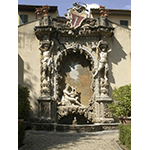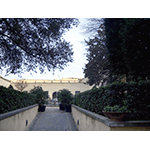Garden of Palazzo Vivarelli Colonna
Enclosed by the Palazzo Vivarelli Colonna, the Murate and two high walls between the via dell’Agnolo and via delle Conce, this garden is one of the many private green areas hidden in the urban fabric. Only the terracotta vases on top of the boundary walls and the large gate on the via delle Conce reveal its presence.
Realised in the first decade of the 18th century by order of the then-owner of the palazzo, Francesco Niccolò Maria Gabburri, the garden was characterised by its Italian, rigorously geometric style, which it conserves to this day. This layout of Renaissance inspiration tended to exalt the garden’s symmetry via the principal lane, aligned with the entrance of the palazzo, where two fountains were sited (one circular at the centre of the parterre, and the other against a wall) to correct the irregularity of the space with an artifice that subjected nature to the rule of human intellect.
The wall fountain built between 1704 and 1708 is the principal element of the garden’s layout. The complexity of the decorative apparatus obtained by using calcareous concretions, elements of sculpture and paintings, reflects the late Baroque taste. The wrought iron guard-rail around the middle basin was added towards the mid 19th century. The presence of fountains not only had a decorative value, but also performed an essential function for the supply and conservation of the water necessary for the garden’s life.
The earthenware vessels containing citrus trees that dot the flower-beds, and the Seville orange espaliers arranged on the sides of the wall fountain, follow the eighteenth-century layout, while the romantic wood with high-trunk plants dates to the first half of the 19th century when the palazzo was property of the Giuntini family. In 1857, the palazzo and garden became property of the Vivarelli Colonna family.
The garden has recently been subjected to rehabilitation thanks to major renovation that has also restored the flowering plants: one flower-bed is reserved to roses, another to the camellia wood.
****************************
Texts by Cristina Bucci
English translation by Victor Beard
Last update 01/feb/2008





